This recipe is a lifesaver when you’ve neglected to apply moisturiser every day like your momma told you (don’t worry, I’m guilty of this too). The title perfectly describes the texture and purpose of this recipe. It is rich, it is ideal for winter, and it lives up to the definition of a “cream” in being denser than light watery lotions. Yet, it still absorbs better than body butters and balms, with only a slight oily residue. Yet, what I love most about this cream is how it softens my skin. This body cream is best for dry, dehydrated, itchy and chapped skin. If you prefer light, non-greasy lotions, then rather give this recipe a miss and make my aqueous cream recipe instead. If you have never made a cream emulsion before, please refer to my basic lotion recipe for step-by-step photos.

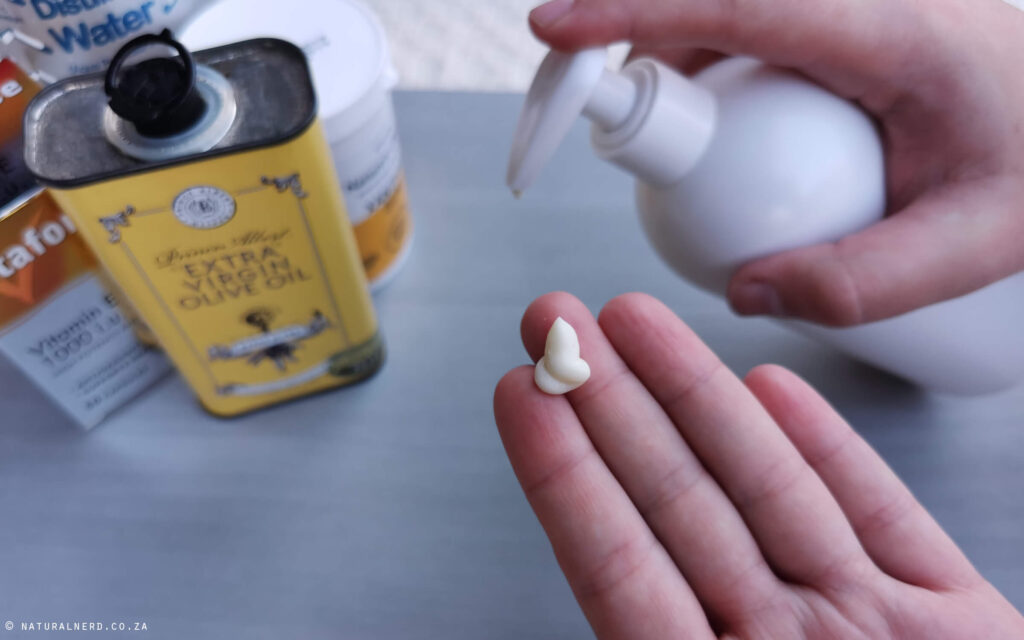
Rich Winter Body Cream
Ingredients
Water Phase:
- 200g Distilled Water (substitute: any hydrosol)
- 32g Vegetable Glycerine
- 4g Hydrolysed Wheat Protein
- 1g Xanthan Gum (about 1/8 teaspoon)
Oil Phase:
- 68g Grapeseed Oil
- 60g Olive Oil
- 28g Eco E-wax
Cool Down Phase:
- 2g Geogard Ultra OR 2ml Geogard 221 (preservative)
- 4g Vitamin E Oil (or 3 large gel capsules)
- Essential oils (optional)
Equipment & Tools:
- Kitchen Scale (to weigh all ingredients)
- Blender or Whisk
- Graduated Pipette or Syringe (to measure small volumes)
- 2x Heat-proof pots or beakers
- 2x Stainless steel spoons
- 2x Hot Plates / Stoves
- pH strips or digital pH meter (optional)
- Thermometer (optional)
- Sterilized container (to store cream)
Instructions
- Makes 400g. This recipe must be followed in weight (grams).
- Combine vegetable glycerine with xanthan gum. Set aside.
- Place all oil phase ingredients into one pot. Don’t forget the Eco E-wax!
- Place the water phase ingredients (and Geogard Ultra, if using) together into another pot. If you are using Geogard 221, refer to step 12.
- Start to heat the contents of both pots at exactly the same time, on the lowest heat setting.
- When the water becomes warm, add the glycerine-xanthan mixture to the water phase and mix well. The water will become murky and thicker, like a gel.
- Do not allow the ingredients in either pot to boil or get above 70’C. The contents should get hot, but not boiling hot. If you can’t get both pots to the same temperature, rather have the water phase hotter.
- Once the contents of both pots are the same hot temperature (approx. 70’C), combine them by adding the oil phase to the water phase.
- Whisk manually for 2 minutes, or blend for 10-20 seconds, until you see that the oil has combined with the water and the mixture is uniformly pale and creamy. This is your cream.
- Set your cream aside to cool down to room temperature. Do not cover with a lid.
- Test the pH of the final product and, if necessary, correct it to be between pH 5 – 5.5. See notes for more information.
- Follow this step only if you are using Geogard 221, otherwise ignore this step completely. Use a graduated pipette to add the Geogard 221 preservative when the cream has cooled completely. Ensure that you mix this in very well, so that it is evenly distributed. If you are using Geogard Ultra, refer to step 4 instead.
- Stir in the Vitamin E oil and essential oils. Maximum essential oil dosage: 50 drops per 400g.
- Transfer your lotion into a sterilised container using a funnel if necessary, and store away from direct sunlight. Use within 3 months.
Notes
- My personal essential oil blend: 15 drops Rosemary, 15 drops Grapefruit, 10 drops Lemon, 5 drops Basil, 5 drops Thyme. These essential oils have been chosen, because they improve skin tone and circulation.
- Essential oils for dry and itchy skin: lavender is best. Other options include rose, geranium, chamomile, sandalwood, frankincense.
- The preservative is necessary, since there is water in this recipe. Water invites bacteria. Without the preservative, this lotion will have a maximum shelf life of one week, even if it’s kept in the refrigerator. Without a preservative; bacteria, fungus, mould and yeast will start to grow.
- You may use any preservative, but bear in mind that each preservative has different applications and usage rates. So make sure to read the manufacturer’s directions and adjust the recipe accordingly.
- When I make this recipe, the pH tests at 5.4 which is perfect. If you test it and it is too high, then add a few drops of a 25% citric acid solution. To make this solution, dissolve 1 part citric acid in 4 parts distilled water (in weight). In other words, 1 gram citric acid dissolved in 4 grams distilled water. Or buy the ready-made solution here. Mix in a few drops at a time, retest and repeat until you get between pH 5 and 5.5. If the pH is too low, do the same with a 25% bicarbonate of soda solution.
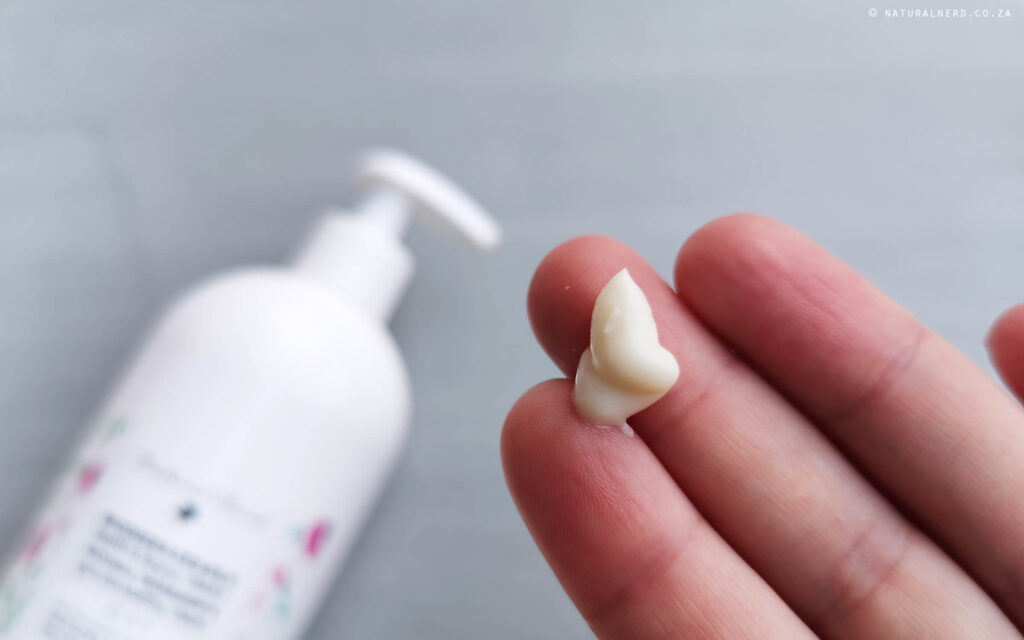
Recipe variations
Substitutes:
You may substitute the oils in this recipe with any other oils as long as you use the exact same weight. The best substitute for grapeseed oil is sunflower oil or sweet almond oil. The best substitute for olive oil is hemp seed oil. If you do substitute, I cannot guarantee that it will have the same texture, colour or scent as my recipe, since each oil brings different properties to creams. You can also use guar gum instead of xanthan gum. You can also substitute hydrosols for the distilled water.
Changing quantities:
If you want to make a bigger batch, you may multiply the quantities. For example, multiply all ingredients by 2 to make 800g of cream. Although, this cream is thick, it does still work in a pump bottle.
Note on preservatives:
When I make this recipe, I use the preservative Geogard 221, which is a golden liquid, whereas Geogard Ultra is a powder. You may use any cosmetic preservative you wish, but you must adjust the recipe accordingly. Remember that each preservative has its own directions for use, so simply adjust the instructions in this recipe about when to add the preservative, and how much of it to use according to the manufacturer’s instructions.
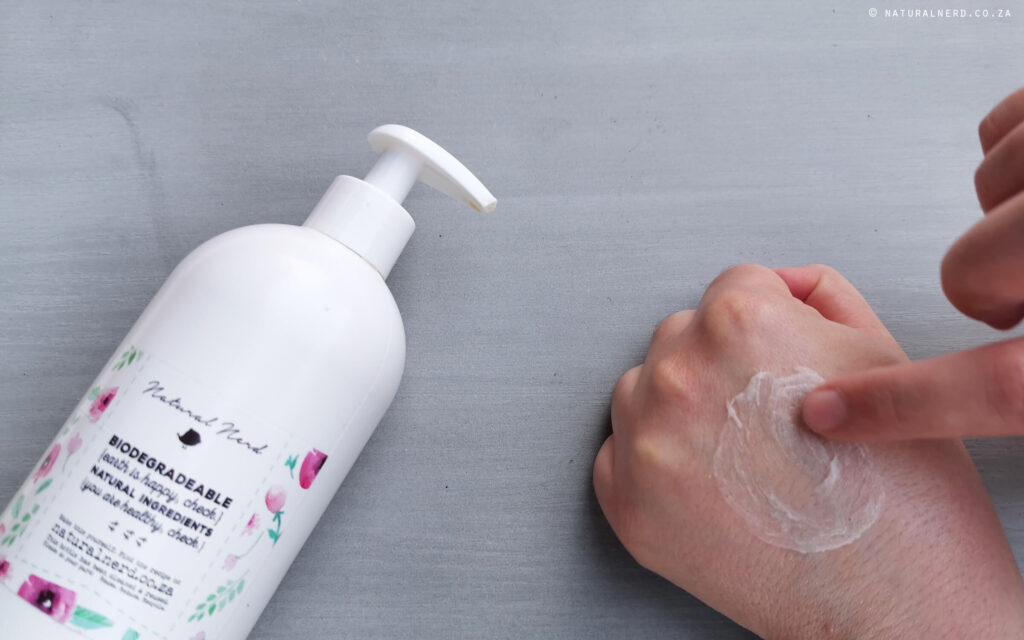
COST & SHELF LIFE
Cost Price: R 64.53 per 400g excluding essential oils (in 2020, based on the best retail prices I’ve found).
Lasted me about: 1 month using every night on my entire body.
Estimated shelf life: 3 months if you include the preservative, and store away from direct sunlight. Without the preservative, this lotion only has a shelf life of 1 week when stored in the refrigerator. Please note that adding ingredients like vitamin E oil and anti-bacterial essential oils will not effectively preserve your product.
CHALLENGE
Leaves a slight oily residue, but it’s not as greasy as oil-based body butters and balms. If this bothers you, apply at night.
CHERRY ON TOP
- Makes your skin feel silky soft when absorbed.
- Suitable as an everyday, all-over body cream in winter. Use it on your hands, feet, face, body. One product for everything.
- You can use this recipe as a base for an anti-ageing night cream.
- See the before-and-after photos below for the results after 1 week of daily use.
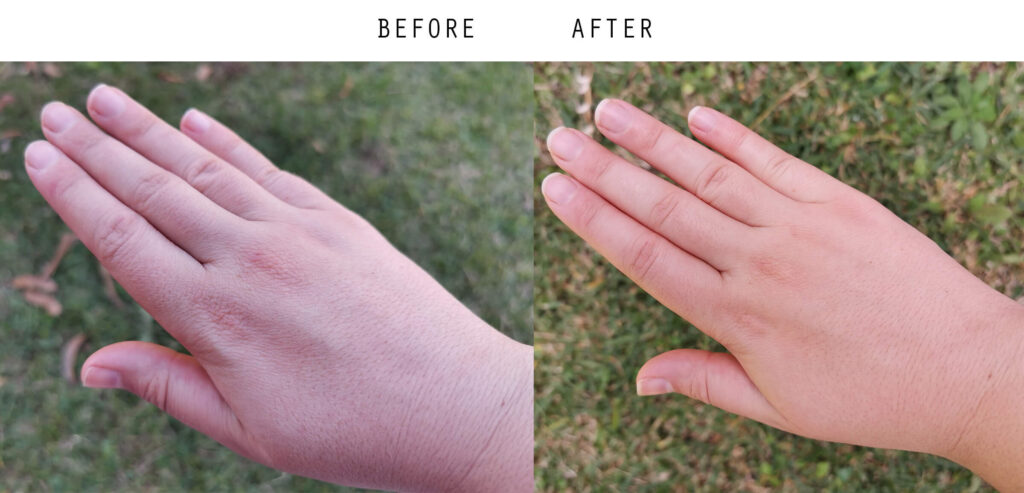
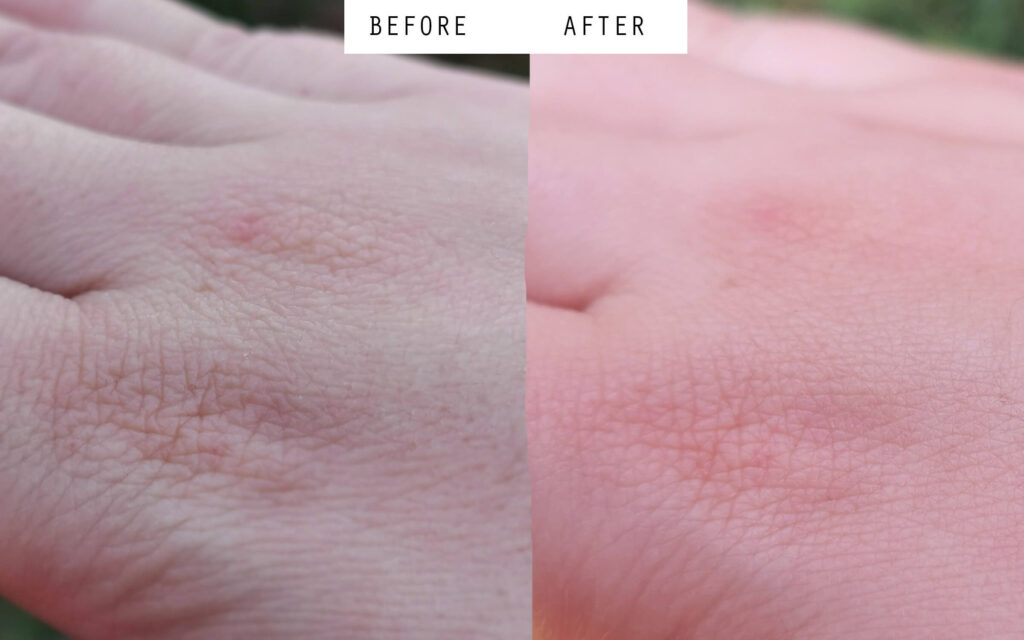
INGREDIENTS
- Distilled water: is a pure form of water without additional minerals, salts and other deposits which typically shorten the shelf life of a lotion. You can find distilled water at most pharmacies. Don’t confuse distilled water with filtered, spring or purified water – they are not the same thing. (Buy here)
- Vegetable glycerine: moisturises the skin and retains moisture in the skin by acting as a protective barrier that locks in moisture. It is also necessary to hydrate the xanthan gum in the recipe to prevent clumps from forming. (Buy here )
- Hydrolysed wheat protein: is also known as phytokeratine. It helps skin retain its moisture, and is high in amino acids. It also minimises pores, smoothes, softens and firms the skin. Avoid this ingredient if you have celiac disease. (Buy here)
- Xanthan gum: stabalizes the lotion so that it does not separate or curdle in heat. Xanthan gum is a sugar derived from either corn, soy or wheat. (Buy here)
- Olive oil: contains anti-ageing antioxidants and hydrating squalene, making it superb for hair, skin, and nails. It is an excellent moisturiser for dry skin, and is rich in vitamin A, E, D and K. (Buy here)
- Grapeseed oil: is a hypoallergenic oil with a low comedogenic score, making it suitable for all skin types. It is one of the lightest and best absorbed carrier oils, and it lacks fragrance. Grapeseed oil contains vitamin E, and has been shown to improve skin tone, and help the vitamin C and E in your skin to be more efficient. (Buy here)
- Vitamin E oil: An antioxidant that protects the skin from further sun damage, treats damaged skin, and it helps decrease the signs of lines and wrinkles. (Buy from Faithful to Nature or Dischem)
- Eco E-wax: is a vegetable-based emulsifying wax which allows water and oil to combine without separating. It is also known as Glycerol Monostearate, and is ECOCERT and SOIL association approved for use in natural and organic products. (Buy here)
- Geogard Ultra: is a synthetic preservative composed of gluconolactone and, the organic acid, sodium benzoate in powder form. It is ECOCERT, NATRUE and SOIL association approved for use in natural and organic products. (Buy here)
- Geogard 221: is a synthetic preservative composed of dehydroacetic acid diluted in benzyl alcohol, in liquid form. It is ECOCERT and SOIL association approved for use in natural and organic products. (Buy here)
Need help finding these, or other ingredients? My shopping guide may help you.
RECOMMENDED RETAIL OPTION
If you don’t want to make it yourself, then The Everyday Cream by Skin Creamery is a natural body cream which you can buy. I have not used this product myself, but there are a ton of positive customer reviews. It is, however, much more expensive than making your own body cream.
Do you think that this is an effective body cream for dry, winter skin? If you’ve tried it, please share your feedback in the comments below.

